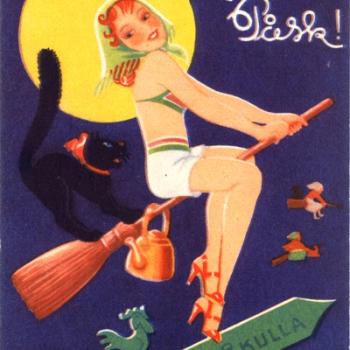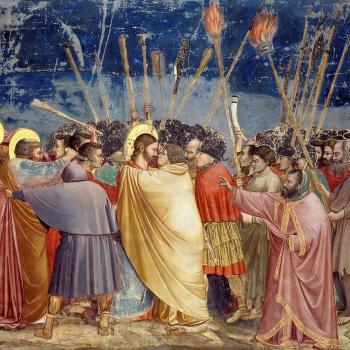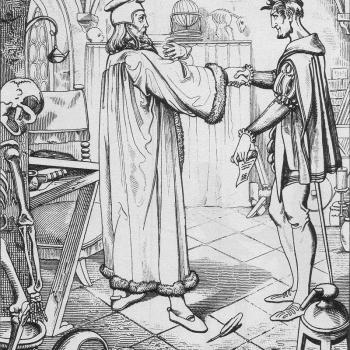 When people come to Traditional Witchcraft, and particularly the Cochrane and 1734 derived systems, they are almost immediately faced with the concept of the compass and the mythos which breathes life into and keeps the whole in perpetual motion. Almost as rapidly does the question ‘how’ formulate within the minds of the many as they approach fresh the poetic and inferential perspective that is so necessary to immerse yourself in to appreciate anything of this experiential work. Alternatively, old hands might yet seek to renew their understanding and hone the perception of the mythos, realising as we do that, with each falling of the scales from our eyes, we are but as children at each new revolution of the compass.
When people come to Traditional Witchcraft, and particularly the Cochrane and 1734 derived systems, they are almost immediately faced with the concept of the compass and the mythos which breathes life into and keeps the whole in perpetual motion. Almost as rapidly does the question ‘how’ formulate within the minds of the many as they approach fresh the poetic and inferential perspective that is so necessary to immerse yourself in to appreciate anything of this experiential work. Alternatively, old hands might yet seek to renew their understanding and hone the perception of the mythos, realising as we do that, with each falling of the scales from our eyes, we are but as children at each new revolution of the compass.
Throughout my adventures in the Western Mystery Traditions, one practice that has proven itself to be of admirably beneficial application is Liber Resh vel Helios, which consists of four daily adorations of the sun as it traverses its stations during a 24 hour period. Written by Aleister Crowley, this is an excellent ritual for attuning the Thelemite to the mythos of the tradition and anchoring any further works firmly in an experiential perspective which adds structure to rituals that proceed from this foundation. With regular use and observation, it has become apparent to me that this ritual is equally applicable in approaching a grounded experience of the compass and attendant castles, forming within the operants world view a deeper understanding and realisation of the lands which, whilst glimpsed throughout the mythic passage of the sun on its daily journey from and to the underworld, shall be explored within the seasonal knots that build the ring. And so, I set out to see if it is a concept and practice that would lend itself to daily adorations, a la Crowley’s Liber Resh, in which we attune to the compass and its kings. In addition, many often wonder what daily rituals they can incorporate into their toolbox and, if properly conceived and utilised, this might produce some acceptable results if we can familiarise ourselves with the force of the castles that reign in their time.
Approaching this from the angle of Traditional Witchcraft (as opposed to modern Wicca), it seems pertinent to begin with Robert Cochrane’s document known among students of his work as the ‘Basic Structure of the Craft’ (BSotC). Using this source material, we have a cosmos which informs our very compass and mythos which activates and works it, and descriptions and names which can be readily put to immediate use in our endeavours.
Within the literatures of the ‘Celtic’ myth are descriptions and prayers that correlate well with the Cochrane Castles, underpinned by the work of poet and writer Robert Graves in his seminal, and flawed, work The White Goddess. Among those most beautiful collections are the Carmina Gadelica, a collection of folk hymns, prayers, chants, poems and invocations gathered between 1860 and 1909 in Scotland. Within, we find some adorations most useable within our schema, and echoing Crowley’s own Liber Resh remarkably.
Without further ado, here is presented a daily practice of adorations to the sun, hailing Apollo Helios, as he achieves the Castles of the four Winds and assumes the mask-face of those resident energies. As a form of invocation, it is advised that you become as familiar with the descriptions of the Kings as possible to achieve ‘Assumption of the Godform’, that is to say visualise the descriptions of the King worked with overlaid your own, sympathetically experiencing the force of character of each quarter and awakening those parts of your self. For example, Luci would imbue a sense or even physical feeling of fire, warmth, the energetic bursting of bud and leaf, the quickening. This transforms the practice from merely reciting words and actually conjuring the spirit of the wind gods and awakening your senses to those characteristics of the force which blows from that particular direction. In this way, experiential understanding is attained, better attuning us to the knots and castles of the wind gods. Descriptions of the gods are taken from Cochrane and the Prayer is derive from the Carmina Gadelica, song 316 & 317, The Sun (Carmichael, 1992).

Descriptions of the gods adapted from BSotC by Robert Cochrane:(Cochrane and Jones, 2002)
East: The Castle of Light, surrounded by fire, ruled over by Luci, the divine child. He is visualised as a bright golden light moving quickly, with wings. Thieving and mischievous.
South: The Castle of Life, built upon the earth and surrounded by trees, ruled over by Carenos. Visualised as a horned figure, with curling ram’s horns, He is the god of the fertility cultus and everything about Him is connected with life growth and strength.
West: The Castle of Paradise, beneath the depths of the sea, ruled over by Node. He is visualised as a mature man, with golden light playing from Him, with a lion at His feet and eyes that are wise and sad. He is the King of all true wisdom, noble, ever fighting, equivalent to King Arthur.
North: The Castle of Weeping, high in the clouds, ruled over by Tettens. Visualised as a tall dark man, shadowy, cold and deadly, unpredictable, yet capable of great nobility, since he represents truth.
Rubric:
At dawn, or when first rising from slumber, face the east, assuming the godform of Luci and invoke:
Hail, to thee, sun of the seasons,
From the realm of Light,
Upon the wind of Luci.
As thou travellest the skies aloft;
Thou risest up on the peaceful wave-crest
Like a queenly maiden in bloom
At noon, face the south and, assuming the godform of Carenos, invoke:
Hail, to thee, sun of the seasons,
From the realm of Life,
Upon the wind of Carenos.
As thou travellest the skies aloft;
Pouring upon us gently and generously,
Glory to thee thou glorious sun.
At twilight, face the west and, assuming the godform Node, invoke:
Hail, to thee, sun of the seasons,
From the realm of Paradise,
Upon the wind of Node.
As thou travellest the skies aloft;
Thou liest down in the destructive ocean
Without impairment, without fear.
At midnight, or before retiring to sleep, face the north and, assuming the godform Tettens, invoke:
Hail, to thee, sun of the seasons,
From the realm of Weeping,
Upon the wind of Tettens.
As thou travellest the skies aloft;
Thy steps are strong on the wing of the heavens,
Thou art the glorious mother of the stars.
When the adoration has been recited, and upon ‘Assumption of the Godform’, complete each of the four rites with the Sangreal Prayer1 (Jones and Valiente, 1990):
Beloved Bloodmother of my especial breed,
Welcome me at this moment with your willing womb,
Let me learn to live and love with all you are,
So my seeking spirit serves the Sangreal.
Carmichael, A. (1992) Carmina Gadelica: Hymns and Incantations from the Gaelic. 1st edn. Floris Books.
Cochrane, R. and Jones, E. J. (2002) The Robert Cochrane Letters: An Insight into Modern Traditional Witchcraft. 1st edn. Edited by M. Howard. Capall Bann Publishing.
1Written by Qabbalist, friend of Robert Cochrane and Evan John Jones, William Gray.

















